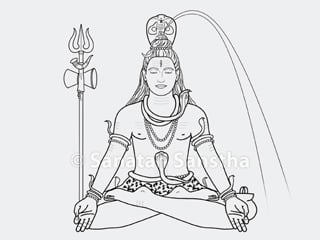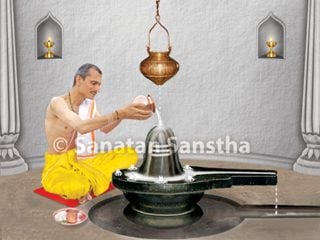Contents
2. The tandav dance and its seven types
Everyone is familiar with Shiva’s Natraj form, especially one who is associated with the fields of art and literature. In this article you will find information on this form of Shiva.

Nataraj
Origin and meaning
Shiva is believed to assume two states – the samadhi (Superconscious) state and the tandav or lasya dance state. The samadhi state is His nirgun (Non-materialised) and tandav or lasya dance state is His sagun (Materialised) state. Body movements performed to depict a particular event or issue is known as natan or natya. The one who performs this natan is a nat (Actor). Traditionally, it is believed that Natraj is the promoter of dance. Since Shiva is the pioneer amongst actors, the title of Natraj is accorded to Him. The universe is His dance school. Just as He is the dancer, He is its observer too. Natraj plays the role of bringing about activity in the universe through the commencement of His dance and merging the visible and invisible Creation into Himself when He stops it. Thereafter, He remains alone, engrossed in Anand . In short, Natraj is the manifest form of all activity of God. Natraj’s dance is considered to represent the five actions of God, namely Creation, Sustenance, Dissolution, the covering of the Great Illusion and initiation (God’s grace to get liberated from the Great Illusion).
The tandav dance and its seven types
Origin of the tandav dance is explained as follows
प्रयोगमुद्धतं स्मृत्वा स्वप्रयुक्तं ततो हरः ।
तण्डुना स्वगणाग्रण्या भरताय न्यदीदिशत् ।।
लास्यमस्याग्रतः प्रीत्या पार्वत्या समदीदिशत् ।
बुद्ध्वाऽथ ताण्डवं तण्डोः मत्र्येभ्यो मुनयोऽवदन् ।। – Sangitratnakar, Adhyaya 5, Shloka 5, 6
Meaning : Then Shiva remembered and showed the uddhat dance (that He had performed earlier) to Sage Bharat through the chief of His attendants (known as Tandu). He also made Parvati perform the lasya dance with great enthusiasm in front of Sage Bharat. Lasya is a dance performed by women, wherein the hands remain free. Realising that the dance performed by Tandu was tandav, Sage Bharat and others later taught these dances to mankind. The dance form in which the sound emitted by every cell in the body is Shivatattva-predominant, is known as the tandav dance. It is a dance performed by males and consists of mudras; for instance, the dnyanmudra is performed by touching the tip of the thumb to the index finger. As a result, the mounds of Jupiter and Venus get joined, meaning, the male and female unite.
This dance form has seven types –
1. Anandtandav,
2. Sandhyatandav (Pradosha dance),
3. Kalikatandav,
4. Tripuratandav,
5. Gouritandav,
6. Sanhartandav,
7. Umatandav.
Of these seven types, the verse Shivapradosha (or pradosha) describes the Sandhyatandav as – Shiva offers Gouri, the Creator of the three worlds, a throne studded with precious stones and performs this dance in the evening. When Shiva dances, Saraswatidevi plays the veena (A stringed musical instrument), Indra plays the flute, Brahma keeps the rhythm, Lakshmidevi sings, Vishnu plays the mrudanga (A type of drum) and all the other Deities stand around and watch the dance. In this dance, Shiva has two arms, and the scene of a demon being crushed under His feet is absent.
Of the seven types mentioned above, the Gouritandav and Umatandav are fearsome in depiction. In these dances, Shiva assumes the form of Bhairav or Veerabhadra and is accompanied by Gouri or Uma. He performs this fearsome dance with the spirit attendants in a smashan where the corpses burn.
Among Natraj’s sattvik dance forms (with the Sandhyatandav), the nadanta dance is also renowned. The world-famous Idol of Natraj at Chidambaram is in this very posture. Followers of the Shaiva and the Shakta sects consider these dances to be symbols of specific Principles. In their opinion, during such a destructive, fearsome dance, Shiva not only destroys the world but also frees jivas (Embodied souls) from bondage. The smashan is selected for the dance to depict that the ego of the jiva is reduced to ashes. Deities as well as demons are enthusiastic to accompany Shiva during the tandav dance.
The table given ahead shows how significant the various postures adopted in a tandav dance are.
Meaning |
|
| 1. Different earrings in each ear | Ardhanarishwar |
| 2. Damaru in the rear right hand | Creation of nada and shabda Brahman |
| 3. Fire in the rear left hand | Purification of animate and inanimate creation |
| 4. Front right hand | Protection to devotees |
| 5. Front left hand Points to the foot raised for | Liberation of jivas |
| 6. Demons Apasmar or Muyalak crushed under the right foot | Destruction of avidya (Ignorance) or adnyan (Lack of knowledge) |
| 7. Surrounding circle | Cycle of Maya |
| 8. Hand and foot touching the chakra | Purifying Maya |
| 9. Five radiant fireballs arising spontaneously from the flames of the chakra | The subtle Panchatattvas |
Lasya and Tandav dance
Lasya dance |
Tandav dance |
|
| 1. Dancer | Female | Male |
| 2. Posture | Related to step movements | Some posture is a must |
| 3. Abhinaya (Note 1) | Yes | No |
Note 1 – Abhinaya : The word is formed thus – abhi + naya. Abhi means well organised, solid and naya means emotion. Abhinaya (Acting) generates energy. The science of drama by Bharatmuni is referred to as the fifth Veda. (Back)

 Unique Spiritual experiences of Miss Smital Bhujle after chanting Om Namah Shivay
Unique Spiritual experiences of Miss Smital Bhujle after chanting Om Namah Shivay How to celebrate Mahashivaratri during adverse times?
How to celebrate Mahashivaratri during adverse times? Spiritual science underlying the ritual of offering a bel (aegle marmelos) leaf to Deity Shiva
Spiritual science underlying the ritual of offering a bel (aegle marmelos) leaf to Deity Shiva Spiritual characteristics of Deity Shiva
Spiritual characteristics of Deity Shiva What is the significance of consecrating the Shivapindi with milk on Mahashivratri?
What is the significance of consecrating the Shivapindi with milk on Mahashivratri? How to take darshan of Shiv pindi ?
How to take darshan of Shiv pindi ?
Why do Hindu men don’t cut their hair and don’t shave their Beard on Tuesday? What’s the reason behind this practice?
Namaskar Meghana ji,
As per Dharmashastra, Men can cut their hair on Tuesdays.
When should men avoid cutting hair ?
1. Men should not have a haircut on inauspicious days, new-moon days and full-moon days; because on these days Raja-Tama-predominant waves are more active in the atmosphere.
2. After a haircut, tips of the hair remain exposed and hence, Raja-Tama-predominant waves can get easily transferred into the hair through hair follicles and remain congregated at hair roots.
3. This results in creation of centres of negative energies at the roots of the hair; hence, an act like cutting hair should not be carried out on days when there is a predominance of Raja-Tama components.
4. As far as possible, hair should not be cut in the noon, evening and night, because these periods also help in activating Raja-Tama-predominant waves.
5. Hair should not be cut on festival days like Rāmnavami, Hanumān Jayanti etc.
6. Hair should not be cut on the date and tithī of birth.
Regards,
Sanatan Sanstha